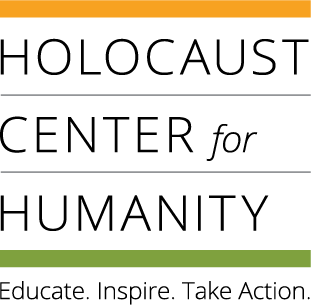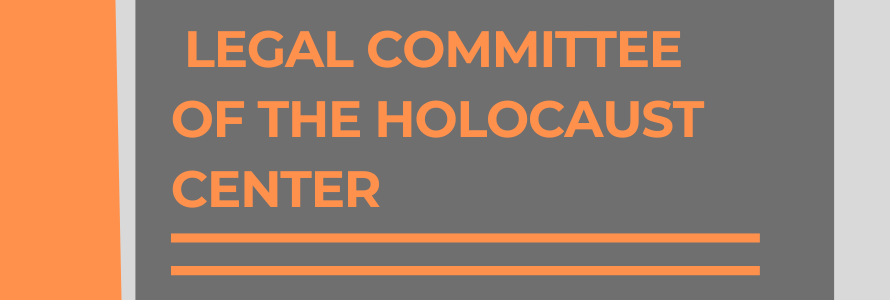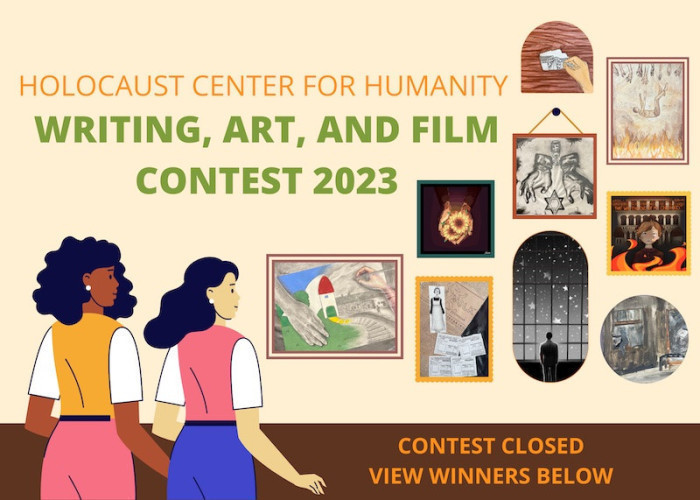Legal Committee
A forum for discussions linking lessons from the Holocaust and other genocides with contemporary issues in a legal context. It is comprised of lawyers with a wide range of practice areas, and a common interest learning about the Holocaust.
2024 Legal Committee Members
Marc Boman (Retired), Preston, Gates & Ellis, LLP
Kathy Feldman, Karr Tuttle Campbell
Ronald Friedman, Karr Tuttle Campbell
Maria Hodgins, Karr Tuttle Campbell
Lucas Michels, Ironmark Law Group, PLLC
Jay Riffkin, Dorsey & Whitney, LLP
Sabina Shapiro, Stoel Rives LLP
Rob Spitzer, Foster Garvey PC
Jeremy Wood, Fisher Phillips
Previous Continuing Legal Education (CLE) Sessions
Profits & Persecution: German Big Business and Nazi Crimes | Peter Hayes, PhD
Hitler's Courts: The Misuse of Executive and Judicial Power | Joshua Green
Restitution After WWII: Suing Hitler's Business Partners | Michael Bazyler
The Crime of Complicity: Law and the Bystander from the Holocaust to Today | Amos N. Guiora
Law as an Instrument of Mass Crimes: The Legal System Under the Third Reich | James J. Grosfeld
If you are interested in joining the Legal Committee of the Holocaust Center, email This email address is being protected from spambots. You need JavaScript enabled to view it..
Demetria's secret test page
This page should be deindexed and not visible in menus. If you found it, please email This email address is being protected from spambots. You need JavaScript enabled to view it. with information about where you found it!
John Lynch
Joe Thomas
Jean Torres
Doris Meyer
Ronald Reid
Heading
Some representative placeholder content for the three columns of text below the carousel. This is the first column.
Heading
Another exciting bit of representative placeholder content. This time, we've moved on to the second column.
First featurette heading. It’ll blow your mind.
Some great placeholder content for the first featurette here. Imagine some exciting prose here.
Oh yeah, it’s that good. See for yourself.
Another featurette? Of course. More placeholder content here to give you an idea of how this layout would work with some actual real-world content in place.
And lastly, this one. Checkmate.
And yes, this is the last block of representative placeholder content. Again, not really intended to be actually read, simply here to give you a better view of what this would look like with some actual content. Your content.
Student Art Contest
Art of Remembering: Student Art Contest Honoring Holocaust Survivors
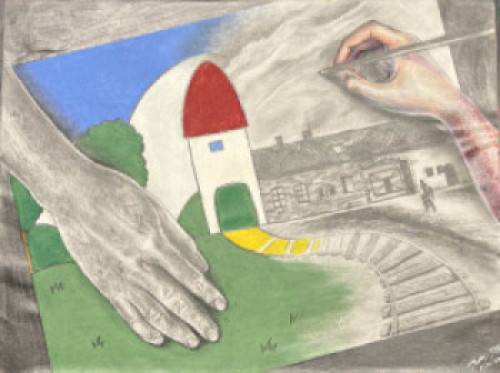 The Art of Remembering: Student Art Contest* challenges students to explore the history and personal stories of the Holocaust and to consider how these stories connect to our lives today.
The Art of Remembering: Student Art Contest* challenges students to explore the history and personal stories of the Holocaust and to consider how these stories connect to our lives today.
Open to students in grades 5-12 from Washington, Idaho, Montana, and Alaska.
The Holocaust Center for Humanity's Art Contest is offered in memory of Jacob Friedman, a Holocaust survivor who recognized the incredible value of education. (Read more about Jacob Friedman below.)
Prizes are awarded in two categories:
- Category 1 - Grades 5-8
- Category 2 - Grades 9-12
First Prize: $200 | Second Prize: $100 | Third Prize: $50
Deadline for Entries: May 17, 2024
*Our Writing, Art, and Film Contest has evolved into our Art Contest! This means that we will now only be accepting handmade and computer-made art for the contest.
Navigate directly to a subtopic:
2024 Prompt | Prizes & Categories| Rules & Requirements | How to Enter | FAQs | See Previous Winners
Prompt
Background:
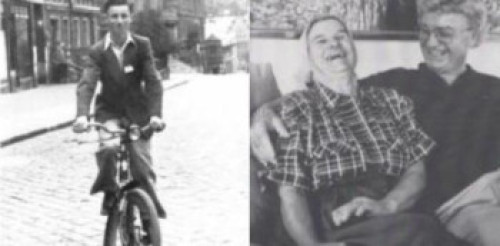
It was 1944 and Henry Friedman was 15 years old. For 18 months, he had been hiding in the tiny cramped loft of a barn with his mother, brother and teacher, while the Nazis and their collaborators hunted every Jewish person. Finally, the Nazis fled, and it was safe for them to come out. Emaciated, starving, and having lost so much, Henry, along with his brother and parents were the only Jewish family from the city of Brody, Poland to survive the Holocaust.
Now, 80 years later, on the anniversary of Henry's liberation, Henry continues to tell his story of surviving the Holocaust, owing his survival to the remarkable actions of Julia Symchuk, a non-Jewish teenage girl and her family that risked their own lives to hide him.
Henry Friedman, whose story is one of many featured in our "Survivor Encyclopedia: Washington State", founded the Holocaust Center's art contest in honor of his father, Jacob, who instilled in Henry at a young age the importance of education. Through lessons of the Holocaust, we learn the importance of standing up for others, speaking out against hatred, and that each person can make a difference.
Photos: On left, Henry Friedman one year after liberation, 1945, Galicia, Poland. On right, Julia Symchuk reunited with Henry Friedman in Seattle, WA 1989.
Prompt:
Choose one or more of the Holocaust survivor profiles from the "Survivor Encyclopedia: Washington State." In the art form of your choice, convey one local survivor story, or a piece of that story, which inspires or stands out to you. In your artist's statement of 125 words or less, tell us why you chose the story, image, or scene that you did.
Please read the prompt and the rules carefully. Please see the rules for details on the sizes of items and types of items that we accept. Entries that do not follow the rules or that don't answer the prompt will not be judged.
Prizes & Categories
Entries will be judged in the following two groups with three prizes available for each.
Grades 5-8 Art
First Prize - $200 | Second Prize - $100 | Third Prize - $50
Grades 9-12 Art
First Prize - $200 | Second Prize - $100 | Third Prize - $50
Winning entries will be displayed at the Holocaust Center, at events, and in publications throughout the year. Winners will be announced in June 2024.
Rules & Requirements
All entrants must review the Official Rules.
Requirements for Artwork
- Art pieces must not exceed 18”x24” in size and must be flat.
- Artwork must be in an acceptable medium.*
- *Created by hand (drawing, painting, prints, film photography, multimedia)
- *Created using a computer (with a computer program or digital photography submitted as jpg, tiff, png, or other digital file formats).
- For charcoal, chalk, and pastel artworks, please use fixatives.
- We are unable to accept sculptures or any form of 3D art.
- To qualify, all artwork must meet the prompt, including a clear reference to a Holocaust survivor featured in our "Survivor Encyclopedia: Washington State". Artworks that do not draw reference to a survivor will not be judged. Artworks that reference a survivor not featured in the Survivor Encyclopedia will not be judged.
- Entries that do not follow requirements will be disqualified.
How will artwork be judged?
A panel of judges will review the entries. Judges are educators, artists, writers of various faiths and backgrounds. They will be looking for creativity, thoughtfulness, and an understanding of the prompt. Judges will be looking for you to relate your knowledge and studies of the Holocaust to your own personal life. Judges will also be looking for proper spelling, grammar, punctuation, and artistic talent.
A thorough breakdown of our judging criteria can be viewed on the rubric for this year’s contest.
All artworks must meet the prompt, including a clear reference to a Holocaust survivor featured in our "Survivor Encyclopedia: Washington State". Artworks that do not draw reference to a survivor will be disqualified. Artworks that reference a survivor not featured in the Survivor Encyclopedia will be disqualified.
Are there special considerations that you want the judges to know? If so, please include this in your artist's statement.
More
- Group and class projects are welcome. All students who participated in creating the work should be noted in entry form.
- Entries will become the property of the Holocaust Center for Humanity.
- The Holocaust Center reserves the right to publish and/or display all work.
How to Enter
UPLOAD YOUR ENTRY
You will need:
- Your art piece in a jpg, tiff, png, or pdf format (TIP: Make sure you get a good photo or scan of your artwork! Check the lighting and try to avoid shadows and reflections.)
- Your artist statement (you will be asked to type, or copy and paste it into the online form)
- The name of the survivor you focused on in your entry
MAIL OR DROP OFF YOUR ENTRY
You will need:
- A printed copy of the ENTRY FORM, filled out and attach it to your art work.
- Your artist's statement must be written legibly on the entry form or printed and attached to your art. Make sure it is clearly labeled with your name, email and/or phone.
- Your art work must have your name, email, and phone number on it, seperate from the entry form and artist's statement. (in case the artwork gets separated from your entry form)
- If dropping off, please email This email address is being protected from spambots. You need JavaScript enabled to view it. or call (206) 582-3000 to coordinate a time.
- Address (for mail or dropping off):
- Holocaust Center for Humanity, Attn: Art Contest, 2045 2nd Avenue, Seattle, WA 98121
Frequently Asked Questions (FAQs)
1. What are the judges looking for?
A panel of judges will review the entries using a rubric. Judges are educators, artists, writers of various faiths and backgrounds. They will be looking for artistic talent, creativity, thoughtfulness, and an understanding of the prompt. Judges will also be looking for proper spelling, grammar, and punctuation in your artist’s statement.
Click to see the rubric used for judging
Are there special considerations that you want the judges to know? If so, please include this in your artist's statement.
2. Can I reference a survivor story that isn’t local?
This year’s prompt requires students to use a local survivor story that is found in our "Survivor Encyclopedia: Washington State”. Submissions that don’t reference a survivor from this page or don’t reference any survivor will be disqualified for not following the prompt.
3. Do I need a bibliography? Do I need to tell you where I got photos, facts, quotes from?
If you are making an artistic representation of an existing photo or piece of art, be sure to cite it. Otherwise, based on this year’s prompt, the survivor story you chose should be coming from the "Survivor Encyclopedia: Washington State” and therefore, does not need to be specifically cited.
4. Do I have to write an artist's statement?
Yes. It should be 125 words or less. Please include the statement with your artwork when you submit your entry form either virtually or by mail. Entries submitted by mail/drop-off need to have their entry form, containing their artist’s statement, attached.
5. Is there a good short definition of the Holocaust?
The Holocaust refers to a specific event during the 20th century. It was the state-sponsored, systematic persecution and destruction of European Jewish people by the Nazis and their collaborators (helpers) between 1933 and 1945. While Jews were the primary target of Nazi hatred, the Nazis also persecuted and murdered Roma and Sinti people, Jehovah’s Witnesses, Poles, and people with disabilities. Six million Jews (two-thirds of the European Jewish population) and five million others were murdered in the Holocaust.
6. Who sponsors the contest?
The Holocaust Center for Humanity. The Holocaust Center is a non-profit organization located in Seattle. For more information about the Holocaust Center, visit our About Us page on our website.
7. Can a Holocaust survivor or speaker come to my classroom?
Yes. The Holocaust Center organizes a speakers bureau of Holocaust survivors and children of survivors. The first step is to read about it on our website and then complete the online form with a few possible dates that you would like the person to come. Speakers need approximately 60-90 minutes.
More about the Speakers Bureau
8. Do you have a list of suggested books and films on the Holocaust for students who want to learn
more?
Yes. Please see the annotated bibliographies for the Holocaust Center's teaching trunks. Choose the trunk at the appropriate grade level for a suggested list of books and films.
More about the Teaching Trunks
See Previous Winners
See the winners of the Holocaust Writing, Art & Film Contest 2023
See the winners of the Holocaust Writing, Art, & Film Contest 2022
Unpacking the Holocaust: 3D Artifact Activity
Background:
All of these objects have a local connection to Seattle and the Pacific Northwest – either the survivors or their family members live/lived here. Tell the students that each artifact tells a different story, experience, perspective of the Holocaust. All of these stories contribute to, or help define the Holocaust.
Instructions:
Explore the objects in the gallery using the guiding questions. Take notes on your findings. If done with a group, discuss your responses together. Then, view and read the artifact summary. Feel free to explore the full artifact write up and the related Survivor Encyclopedia page. Discuss how your thoughts or feelings about the artifact changed after learning more about it. Did the “story” change your initial thinking about your artifact? If so, how?
For full teacher instructions, please visit here.
Writing, Art, and Film Contest 2023
Holocaust Writing, Art, and Film Contest 2023
The Writing, Art, and Film Contest challenges students to explore the history and stories of the Holocaust. Open to students in grades 5-12 from Washington, Idaho, Montana, and Alaska, the contest runs from January to May.
Thank you to all who participated in this year’s contest!
This year, we were honored to have 476 entries from 32 schools across the Pacific Northwest. Entries explored the lives of over 30 Holocaust survivors through art, writing, and film.
Explore our 2023 Winners Booklet for a look into all the award-winning works!
Navigate directly to a subtopic:
Featured Works | Physical Art Winners | Digital Art Winners | Film Winners | Writing Winners | 2023 Prompts
Featured Works
1st Place Grade 9-12 Physical Art
Shelly Netz, Grade 12, Tesla STEM High School
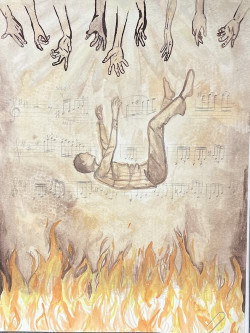
2nd Place, Grade 9-12 Physical Art
Elisha Calaunan, Grade 9 Peninusla High School
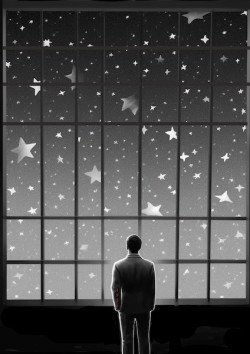
1st Place, Grade 9-12, Digital Art
Brian Yin, Grade, 12, Tesla STEM High School
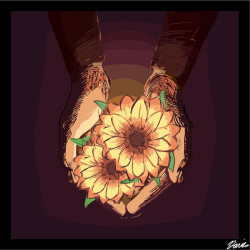
2nd Place, Grade 9-12 Digital Art
Davis Yang, Grade 12, Tesla STEM High School
Physical Art Winners
View the winners’ art in our winners booklet.
Physical Art 5th/6th Grade:
1st Place: Kimber Poser, Grade 6, Emmett Middle School, Emmett, ID
Physical Art 7th/8th Grade:
1st Place: Evie Hobbs, Grade 7, Lake Washington Girls Middle School, Seattle, WA
2nd Place: Caitlin Radtke, Grade 7, Lake Washington Girls Middle School, Seattle, WA
3rd Place: Colin Johnson, Grade 8, Brier Terrace Middle School, Brier, WA
Physical Art 9th-12th Grade:
1st Place: Shelly Netz, Grade 12, Tesla STEM High School, Redmond, WA
2nd Place: Elisha Calaunan, Grade 9, Peninsula High School, Gig Harbor, WA
3rd Place: Aaryan Bondre, Grade 12, Tesla STEM High School, Redmond, WA
Honorable Mention: Triana Fernando Grade 12, Tesla STEM High School, Redmond, WA
Digital Art Winners
View the winners’ art in our winners booklet.
Digital Art 7th/8th Grade:
1st Place: Ayla Sibay, Grade 7, Lake Washington Girls Middle School, Seattle, WA
2nd Place: Katrina Becker, Grade 8, Brier Terrace Middle School, Brier, WA
3rd Place: Davis Wurzburg, Grade 7, Lake Washington Girls Middle School, Seattle, WA
Digital Art 9th-12th Grade:
1st Place: Brian Yin, Grade 12, Tesla STEM High School, Redmond, WA
2nd Place: Davis Yang, Grade 12, Tesla STEM High School, Redmond, WA
3rd Place: Deepalakshmi Thirumal, Grade 12, Tesla STEM High School, Redmond, WA
Honorable Mention: Evan Kim, Grade 12, Tesla STEM High School, Redmond, WA
Film Winners
View the winners’ films in our winners booklet.
Film 5th-8th Grade:
1st Place: Cecilia "Ceci" Garzon-May, Grade 7, Lake Washington Girls Middle School, Seattle, WA
2nd Place: Isaac Royce, Grade 8, Gateway Middle School, Everett, WA
3rd Place: Sophie Shade, Grade 7, Lake Washington Girls Middle School, Seattle, WA
Honorable Mention: Cara Nishimura & Quinn Wiita, Grade 7, Lake Washington Girls Middle School, Seattle, WA
Film 9th-12th Grade:
1st Place: David Gershony, Grade 12, Tesla STEM High School, Redmond, WA
2nd Place: Ananya Unnikrishnan, Grade 12, Tesla STEM High School, Redmond, WA
3rd Place: Ethan Yu, Grade 12, Tesla STEM High School, Redmond, WA
Honorable Mention: Arihant Singh, Grade 12, Tesla STEM High School, Redmond, WA
Writing Winners
View excerpts from our writing winners in our winners booklet.
Argumentative Writing 5th/6th Grade:
1st Place: Sophie Gillick-Downs, Grade 5, Seattle Jewish Community School, Seattle, WA
2nd Place: Eden Benzikry-Stern, Grade 5, Seattle Jewish Community School, Seattle, WA
3rd Place: Daniel Smith, Grade 5, Seattle Jewish Community School, Seattle, WA
Creative Writing 5th/6th Grade:
1st Place: Jacob Anguiano, Grade 6, Park Place Middle School, Monroe, WA
Argumentative Writing 7th/8th Grade:
1st Place: Olivia Chen, Grade 8, Open Window School, Bellevue, WA
2nd Place: Ivy Rudat, Grade 8, Coupeville Middle School, Coupeville, WA
3rd Place: Riley White, Grade 8, Coupeville Middle School, Coupeville, WA
Honorable Mention: Sophia Allman, Grade 8, Horizon Middle School, Spokane Valley, WA
Creative Writing 7th/8th Grade:
1st Place: Arlo Alberts, Grade 8, Sacajawea Middle School, Spokane, WA
2nd Place: Felicity Anderson, Grade 8, Sacajawea Middle School, Spokane, WA
3rd Place: Lexi Mahoney , Grade 7, Lake Washington Girls Middle School, Seattle, WA
Argumentative Writing 9th-12th Grade:
1st Place: Brietta Yi, Grade 11, Newport High School, Bellevue, WA
2nd Place: Jonas Koller, Grade 9, Peninsula High School, Gig Harbor, WA
3rd Place: William Gong, Grade 12, Tesla STEM High School, Redmond, WA
Creative Writing 9th-12th Grade:
1st Place: Rachana Venugopal, Grade 11, Eastlake High School, Sammamish, WA
2nd Place: Claire Poulsen, Grade 9, Freeman High School, Rockford, WA
3rd Place: Kalyn Swanson , Grade 9, Freeman High School, Rockford, WA
Contest Prompts
Option 1: Creative Writing, Physical Art, Digital Art, and Film
Background: “...I consider that everything should be recorded and noted down, even the most gory, because everything will be taken into account." -Yitskhok Rudashevski, teenage diarist murdered during the Holocaust. 1927-1943
This year marks the 80th anniversary of the Warsaw Ghetto Uprising, the largest, symbolically most important Jewish uprising, and first urban uprising in German-occupied Europe. While organized armed resistance was the most direct form of opposition to the Nazis, resistance also included escape, hiding, cultural activity, and other acts of spiritual preservation. Such non-armed resistance refers to attempts by individuals to maintain their humanity, personal integrity, dignity and sense of civilization in the face of their oppressors' attempts to dehumanize and degrade them.
Prompt: Describe or illustrate, in the art form of your choice, how a Holocaust survivor's experience with resistance during the Holocaust can inspire us to make meaningful change today.
*Use one or more entries in the Survivor Encyclopedia: Washington State and/or the story of a survivor about whom you have learned in your class to inform your entry.
Option 2: Argumentative Writing
Grade 5-8
Background: The Holocaust Center for Humanity has been asked to submit a recommendation to the Office of the Superintendent of Public Instruction (OSPI) in the state of Washington regarding whether instruction about the Holocaust should be required in public schools, and if so, in which grades.
The current law, which “strongly encourages” teaching about the Holocaust, indicates that, “The studying of this material is intended to: Examine the ramifications of prejudice, racism, and intolerance; prepare students to be responsible citizens in a pluralistic democracy; and be a reaffirmation of the commitment of free peoples never again to permit such occurrences.”
Prompt: In a cohesive paper, write a letter to the legislature arguing in favor of mandating (requiring) Holocaust education in Washington State schools. Use one or more entries in the Survivor Encyclopedia: Washington State, and/or the life story of a survivor about whom you have learned in your class, as well as at least one of the sources provided to inform your entry.
Grades 9-12
Background: Any study of the Holocaust raises questions about what might have been done to stop the rise and expansion of the Nazis in Europe. The Nazis built a society based on exclusion and persecution of the Jews and other marginalized groups in Germany and, eventually, throughout Europe. Over time, governmental leaders in the United States made choices that drove the American response to the atrocities committed by the Nazis and their collaborators.
Prompt: Was the American government response to the Holocaust (1933-1945) sufficient? In a well organized paper, support your position by discussing two or more specific events related to the American response. In addition, based on what you have learned, how should America respond to human rights violations in other countries? Explain your thinking.
See Previous Winners
See our winners' packet Celebrating Life: Holocaust Writing, Art, & Film Contest 2022 here.
